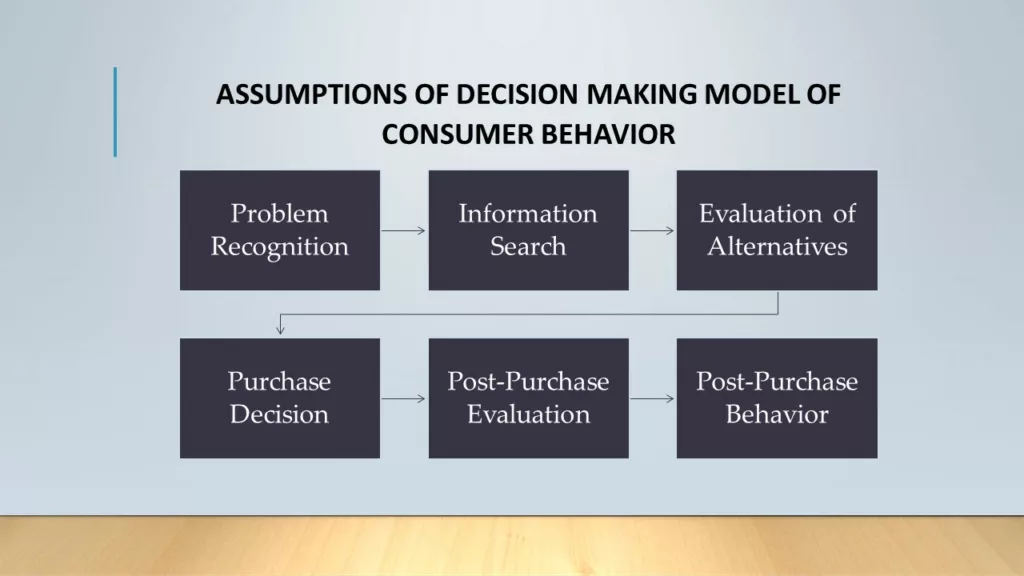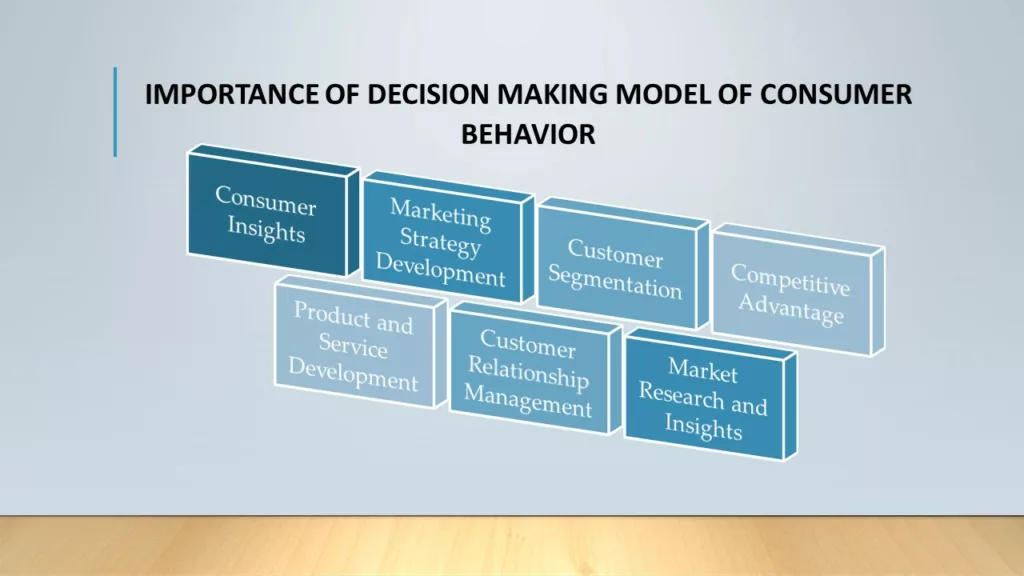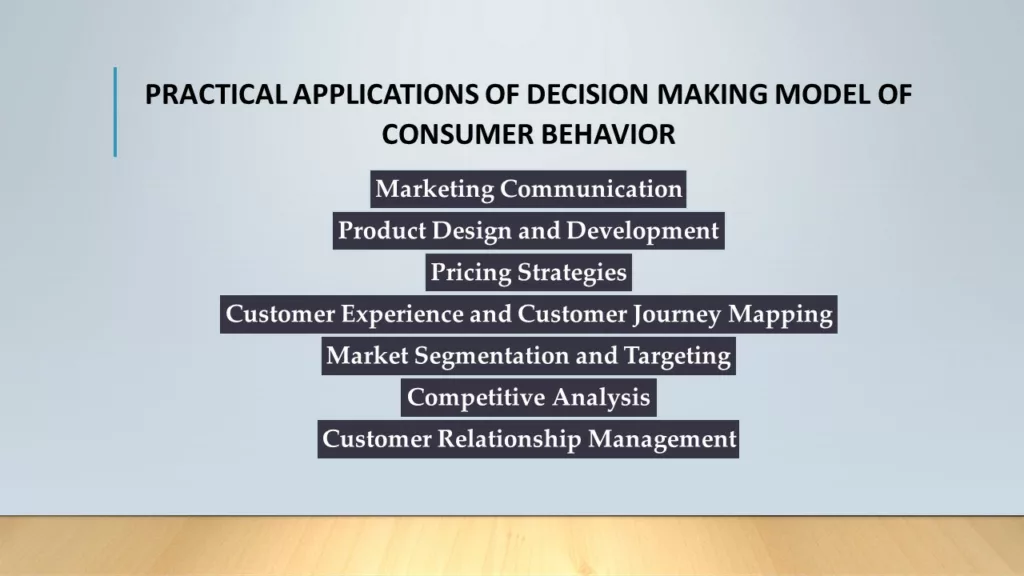DECISION MAKING MODEL OF CONSUMER BEHAVIOR
The decision making model of consumer behavior provides a framework for understanding how consumers make choices and decisions regarding their purchases. It focuses on the cognitive processes, information gathering, and evaluation that individuals go through when making purchasing decisions. This model recognizes that consumer behavior is an active and deliberate process influenced by internal factors, external stimuli, and individual preferences.
By examining the sequential steps involved in consumer decision-making, this model helps marketers gain insights into consumer motivations, perceptions, and the factors that influence their purchase decisions. Understanding this model is crucial for developing effective marketing strategies and tailored interventions that align with consumers’ decision-making processes.
PROCESS OF DECISION MAKING MODEL OF CONSUMER BEHAVIOR
The decision-making model of consumer behavior consists of several sequential steps that consumers go through when making purchasing decisions. These steps provide a framework for understanding the cognitive processes and information gathering involved in consumer decision making. The process typically includes the following stages:

- Problem Recognition: The decision-making process begins with the recognition of a need or problem. Consumers become aware of a discrepancy between their current state and their desired state. This recognition can be triggered by internal factors (e.g., physiological needs) or external stimuli (e.g., advertisements, social influence). Problem recognition may be explicit, such as when a consumer realizes they need a new smartphone, or it may be more subtle, such as recognizing a desire for a better entertainment experience.
- Information Search: Once a problem is recognized, consumers engage in an information search to gather relevant information. This search can be internal (drawing on personal knowledge and experiences) or external (seeking information from various sources such as friends, family, online reviews, or marketing communications). Consumers aim to gather information that will help them evaluate alternative solutions or products that can satisfy their needs or wants.
- Evaluation of Alternatives: Consumers evaluate the available alternatives based on the information they have gathered during the information search stage. They compare the features, benefits, prices, and other relevant attributes of different options to assess their suitability in meeting their needs. This evaluation process involves weighing the perceived benefits against the perceived costs and making trade-offs between different alternatives.
- Purchase Decision: After evaluating the alternatives, consumers make a purchase decision by selecting the product or service they believe will best satisfy their needs or wants. The decision may be influenced by factors such as price, brand reputation, product quality, personal preferences, and perceived value. External factors, such as promotional offers or recommendations from friends, can also impact the purchase decision.
- Post-Purchase Evaluation: After making a purchase, consumers evaluate their decision and the satisfaction they derive from the chosen product or service. They compare their expectations with the actual performance and outcomes experienced. Positive post-purchase evaluation reinforces future purchase intentions and brand loyalty, while negative evaluation may lead to dissatisfaction, regret, or even post-purchase dissonance.
- Post-Purchase Behavior: Post-purchase behavior refers to the actions taken by consumers after the purchase. This may include activities such as product usage, seeking customer support or assistance, providing feedback or reviews, and sharing experiences with others. Positive post-purchase behavior, such as brand advocacy or repeat purchases, contributes to customer loyalty and long-term relationships.
It’s important to note that the decision-making process is not always linear or sequential. Consumers may skip or revisit certain stages based on the complexity of the decision, time constraints, or their level of involvement. Additionally, external factors such as social influence, cultural norms, and situational factors can also influence the decision-making process.
By understanding the decision-making process, marketers can tailor their marketing strategies to meet consumer needs at each stage. They can provide relevant information, create persuasive messages, and address consumer concerns to facilitate the decision-making process and influence consumer behavior effectively.
ASSUMPTIONS OF DECISION MAKING MODEL OF CONSUMER BEHAVIOR
The decision-making model of consumer behavior is based on several assumptions that provide a foundation for understanding and analyzing consumer decision-making processes. These assumptions include:

- Rationality: The model assumes that consumers are rational decision-makers who aim to maximize their utility or satisfaction. It suggests that consumers carefully evaluate the available alternatives, gather relevant information, and make logical choices based on their preferences and perceived benefits.
- Information Processing: The model assumes that consumers actively engage in information processing and decision-making. They seek out and process information to make informed choices. This assumption recognizes consumers as active participants in the decision-making process rather than passive recipients of marketing messages.
- Decision-Making Independence: The model assumes that consumers make decisions independently, without undue influence from external factors or social pressures. It implies that individuals have the freedom to choose based on their own preferences and needs, rather than being swayed by external forces.
- Consistency and Stability: The model assumes that consumer preferences and decision-making processes are consistent and stable over time. It suggests that individuals have relatively stable preferences and make decisions in a consistent manner across different situations and contexts.
- Perfect Information: The model assumes that consumers have access to perfect or complete information about the available alternatives and their attributes. It implies that consumers can accurately evaluate the benefits, costs, and risks associated with different options.
- Well-Defined Needs and Preferences: The model assumes that consumers have well-defined needs, wants, and preferences. It suggests that consumers are aware of their needs and can articulate their preferences, making it easier to evaluate alternatives and make decisions accordingly.
- Utility Maximization: The model assumes that consumers aim to maximize their utility or satisfaction when making purchase decisions. It suggests that consumers carefully weigh the perceived benefits against the perceived costs and select the alternative that provides the highest level of utility.
It’s important to note that while these assumptions provide a simplified framework for understanding consumer decision-making, they may not fully capture the complexity and variability of real-world consumer behavior. Consumers may deviate from rationality, have limited information, face decision-making biases, or be influenced by external factors. Nonetheless, these assumptions serve as a starting point for analyzing and understanding consumer decision-making processes.
IMPORTANCE OF DECISION MAKING MODEL OF CONSUMER BEHAVIOR
The decision-making model of consumer behavior holds significant importance for marketers, researchers, and businesses. Understanding this model provides several benefits:

- Consumer Insights: The decision-making model allows marketers to gain valuable insights into the cognitive processes, motivations, and preferences of consumers. By understanding how consumers recognize problems, gather information, evaluate alternatives, and make purchase decisions, marketers can tailor their strategies and offerings to meet consumer needs effectively.
- Marketing Strategy Development: The decision-making model helps marketers develop targeted and effective marketing strategies. By identifying the stages of the decision-making process, marketers can deliver relevant information and messages at each stage to guide consumers towards choosing their products or services. This understanding enables marketers to create persuasive marketing communications, design appealing product attributes, set competitive pricing, and provide superior customer experiences.
- Customer Segmentation: The decision-making model aids in customer segmentation and targeting. By understanding the different decision-making processes of various consumer segments, marketers can tailor their marketing efforts and offerings to specific groups. This allows for more precise targeting and customization of marketing messages and product offerings to align with the needs and preferences of different consumer segments.
- Competitive Advantage: By comprehending the decision-making process, businesses can gain a competitive advantage. They can identify gaps and areas of improvement in the decision-making experience of consumers and develop strategies to address them. This may involve providing better information, streamlining the purchase process, offering superior customer support, or creating unique value propositions that differentiate their products or services from competitors.
- Product and Service Development: The decision-making model guides businesses in developing products and services that align with consumer preferences and needs. By understanding how consumers evaluate alternatives, marketers can identify the key attributes and features that consumers prioritize in their decision-making. This knowledge can drive product innovation, improve existing offerings, and enhance customer satisfaction.
- Customer Relationship Management: Understanding the decision-making model helps in building and maintaining strong customer relationships. By anticipating and addressing the needs and concerns of customers at each stage of the decision-making process, businesses can foster trust, loyalty, and long-term relationships. This involves providing personalized support, post-purchase follow-up, and ongoing engagement to ensure customer satisfaction and loyalty.
- Market Research and Insights: The decision-making model serves as a framework for conducting market research and gaining insights into consumer behavior. By studying how consumers navigate through the decision-making process, researchers can gather data, conduct surveys, and analyze consumer preferences and behaviors. This information aids in market segmentation, product development, and the formulation of effective marketing strategies.
In summary, the decision-making model of consumer behavior is important as it provides a structured framework for understanding and analyzing consumer decision-making processes. By incorporating this model into their marketing efforts, businesses can develop effective strategies, enhance customer experiences, and gain a competitive advantage in the marketplace.
PRACTICAL APPLICATIONS OF DECISION MAKING MODEL OF CONSUMER BEHAVIOR
The decision-making model of consumer behavior has several practical applications in the business and marketing realm. Here are some key practical applications:

- Marketing Communication: Understanding the decision-making model helps marketers create more effective marketing communications. By identifying the different stages of the decision-making process, marketers can tailor their messages to provide relevant information and address consumer needs at each stage. This ensures that marketing messages are persuasive and influential in guiding consumers towards making a purchase.
- Product Design and Development: The decision-making model aids in product design and development by identifying the key factors that influence consumer choices. By understanding how consumers evaluate alternatives, marketers can focus on designing products with features and attributes that align with consumer preferences and needs. This leads to the creation of products that have a higher chance of being chosen by consumers.
- Pricing Strategies: The decision-making model helps businesses develop effective pricing strategies. By understanding the perceived benefits and costs that consumers consider during the evaluation stage, marketers can set prices that align with consumers’ perceived value. This ensures that the pricing strategy resonates with consumers’ decision-making process and enhances the likelihood of purchase.
- Customer Experience and Customer Journey Mapping: The decision-making model is useful for mapping out the customer journey and designing exceptional customer experiences. By identifying touchpoints and key decision-making stages, businesses can optimize each stage to ensure a smooth and seamless customer experience. This includes streamlining information search, simplifying the purchase process, and providing post-purchase support to enhance customer satisfaction.
- Market Segmentation and Targeting: The decision-making model helps in market segmentation and targeting by identifying consumer segments with different decision-making patterns. By understanding the unique needs and preferences of each segment, businesses can tailor their marketing efforts and offerings to specific groups. This enables more precise targeting and customization of products, services, and marketing messages.
- Competitive Analysis: The decision-making model allows for a comprehensive competitive analysis. By understanding how consumers evaluate alternatives, businesses can assess their own offerings in comparison to competitors. This analysis helps identify areas of strength and weakness, enabling businesses to position themselves effectively in the market and differentiate their products or services.
- Customer Relationship Management: Understanding the decision-making model is valuable for customer relationship management. By recognizing the various stages of the decision-making process, businesses can develop strategies to engage and support customers at each stage. This includes providing personalized recommendations, offering post-purchase assistance, and fostering ongoing communication to build long-term customer loyalty.
In summary, the decision-making model of consumer behavior has practical applications in various aspects of business and marketing. By leveraging this model, businesses can develop targeted marketing strategies, design better products and services, optimize the customer experience, and gain a competitive edge in the marketplace.
CRITICISM OF DECISION MAKING MODEL OF CONSUMER BEHAVIOR
While the decision-making model of consumer behavior is widely used and provides valuable insights, it is not without criticism. Here are some common criticisms of the decision-making model:

- Simplified Rationality: The model assumes that consumers are rational decision-makers who carefully evaluate all available information before making a purchase. However, research has shown that consumers often make decisions based on heuristics, biases, and emotional factors, deviating from strict rationality. The model’s emphasis on rationality overlooks these non-rational influences on consumer behavior.
- Limited Information Processing: The model assumes that consumers have access to perfect information and actively engage in information search and evaluation. In reality, consumers may have limited time, resources, or information, leading to incomplete decision-making processes. The model’s assumption of complete information processing does not account for information overload or selective attention, where consumers focus only on certain aspects of available information.
- Complex Decision-Making Process: The decision-making model simplifies the consumer decision-making process into sequential stages. However, consumer decision-making is often more complex and dynamic. Consumers may revisit stages, consider multiple alternatives simultaneously, or skip certain stages altogether. The model’s linear representation may not fully capture the intricacies of real-world decision-making.
- Influence of Social and Cultural Factors: The decision-making model primarily focuses on individual decision-making processes and overlooks the influence of social and cultural factors. Consumers are influenced by their social networks, cultural norms, and external influences such as advertising and peer recommendations. The model’s individual-centric approach does not adequately address these contextual factors.
- Limited Focus on Post-Purchase Behavior: The decision-making model primarily focuses on the pre-purchase stages of decision-making, such as problem recognition, information search, and evaluation of alternatives. It places less emphasis on post-purchase behavior and the impact of post-purchase satisfaction, loyalty, and word-of-mouth. Ignoring the post-purchase stage can limit a comprehensive understanding of consumer behavior.
- Neglect of Unconscious Processes: The decision-making model largely overlooks the role of unconscious processes and motivations in consumer behavior. Consumers may be influenced by subconscious desires, emotions, and biases that affect their decision-making without conscious awareness. The model’s emphasis on conscious and rational decision-making neglects the influence of these underlying psychological factors.
- Lack of Individual Differences: The decision-making model assumes a uniform decision-making process for all consumers. However, individuals have unique characteristics, personalities, and motivations that influence their decision-making. The model’s generalization of the decision-making process may not account for these individual differences.
It’s important to note that while the decision-making model has its limitations, it still provides a useful framework for understanding consumer behavior. However, researchers and practitioners should be aware of these criticisms and supplement the model with additional perspectives and insights to gain a more comprehensive understanding of consumer decision-making.